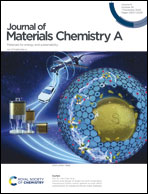An ionic liquid-infused slippery surface for temperature stability, shear resistance and corrosion resistance†
Abstract
The stability of slippery liquid-infused porous surfaces (SLIPSs) is of great significance in long-term applications. In this perspective, herein, a polyionogel membrane was successfully attached on a porous surface to form strong interactions between the porous surface and a lubricant by covalent half-polymerization with unpolymerized ionic liquids (ILs) as the lubricant. The SLIPSs exhibited outstanding temperature stability, as well as a superior capacity and stability of resistance to shear stress. An IL content of about 0.79 mg cm−2 was stably locked in the aluminum oxide (AAO) surfaces at a shear rate of 7000 rpm by an enhanced interaction between the substrate and the lubricants, about two times higher than that of the surfaces without the polyionogel membrane (0.37 mg cm−2). They also have excellent slippery properties with a sliding angle of about 2.29° at a high shear rate of 7000 rpm. The excellent temperature stability and shear resistance of SLIPSs widen their applicability in a harsh environment. Besides, the SLIPSs retained an eminent corrosion resistance after suffering from bending damage, as well as the dye absorption performance. This work showed a special type of interaction between the substrate and lubricant to prepare temperature stable slippery surfaces, thus advancing the application of slippery surfaces in liquid transport devices in harsh environments including an extreme temperature, high shear rate or corrosive environment.



 Please wait while we load your content...
Please wait while we load your content...